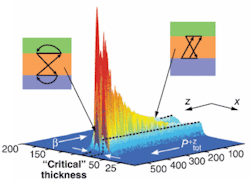
Advances in the use of metamaterials for negative refraction are being fancifully described by the media, but their first real application might be less exotic than some that have been proposed. For example, a new metamaterial could speed up the World Wide Web.
Metamaterials have periodic structures spaced at a distance comparable to the wavelength of light propagating through them, and have unusual optical properties, such as the ability to bend light “backward”—that is, contrary to the direction of normal refraction. Previous negative-refraction approaches have been demonstrated in the microwave region of the spectrum, and have depended on resonances within the metamaterials’ structure that lead to high losses of the incident light.
The recent concurrent publications in Science and Nature of another demonstration of negative refraction caused a familiar media frenzy with speculations of Harry Potter—style invisibility cloaks and untold military applications. Most interesting about the publication, though, is the wavelength at which the effect was seen: squarely in the middle of the telecommunications band at around 1.5 µm.
In two separate approaches, Xiang Zhang and colleagues from the University of California Berkeley demonstrated three-dimensional nanoscale metamaterials that exhibit negative refraction in the near-infrared, and dispense with the lossy resonances. In one report, the effect is seen in 21-layer “fishnet” structures made of alternating layers of silver and magnesium fluoride (see Fig. 1). The researchers went on to make a wedged structure that acted as a prism, diffracting incident light in the characteristic but unintuitive way.1 In another report, members of the same team reported negative refraction in an array of silver nanowires embedded in an alumina matrix.2Envisioning practical uses
Such negative-index materials that work in the telecommunications part of the spectrum are perfectly suited to an idea published last year by Ortwin Hess of the University of Surrey (Guildford, England) and colleagues. The team performed a theoretical study on a tapered metamaterial, shaped so as to exaggerate dispersion. By exploiting the so-called Goos-Hänchen effect, in which linearly polarized light undergoes a phase shift upon total internal reflection, light could be slowed and stopped at the interface between a metamaterial and a material with normal dispersion (see Fig. 2). Shaping the waveguide to tailor the effect to different frequencies gives rise to what the authors referred to as a “trapped rainbow.”3
At the time, the material was a theoretical construction. But with the recent publications, such an approach is now in sight. “I find this particularly exciting since Zhang’s materials are precisely those that we have envisioned in our scheme,” says Hess. The result raises the intriguing possibility that the materials could be implemented as an optical-storage medium in telecom networks. That, in turn, could speed up and streamline routing, one of the industry’s biggest bottlenecks.
While fiber-optic cables can support terahertz levels of bandwidth, dividing and routing different channels to different destinations is currently accomplished electronically. Incoming light signals are detected, digitized, stored, routed, and then regenerated with lasers. “It limits the speed of the whole process to the speed of your electronics,” says Chris Stevens, an engineer from the University of Oxford (Oxford, England). That means limits of a few gigahertz. If, instead, the light signals could be stored directly, the electronic conversion steps could be done away with, resulting in a big jump in speed.
While the nonresonant nature of the newest metamaterials means they are significantly less lossy than prior efforts, they are not lossless—a significant issue for any communications implementation. But several research groups are looking to implement semiconductor quantum dots to provide a gain medium that could exploit metamaterials’ potential for optical traffic control without a loss of signal strength.
Guy Bartal, a coauthor on the Science and Nature papers, says that many options are at their disposal. “Some properties can be altered by external voltage or even with light,” Bartal says. “Due to the unique metamaterial design, a small change in one of the composites can induce a very strong change in the effective properties of the metamaterial—this could be useful in switching and routing.”
What’s more, the nanoscale nature of the metamaterials opens up even more multiplexing opportunities within networks. “The metallic nanowire metamaterial may have applications in a supercompact wavelength-division-multiplexing (WDM) system, in which each dielectric gap may function independently as a nanochannel,” Bartal suggests. “Combining these two concepts may result in about 10,000 channels in a 10 by 10 µm fiber bundle—on top of the multiple frequency-separated channels you can obtain on each waveguide by WDM.”
REFERENCES
- Valentine et. al., Nature, doi: 10.1038/nature07247 (2008).
- Yao et. al., Science, doi: 10.1126/science.1157566 (2008).
- Tsakmakidis et. al., Nature, doi: 10.1038/nature06285 (2007).
D. Jason Palmer | Freelance writer
D. Jason Palmer is a freelance writer based in Florence, Italy.
